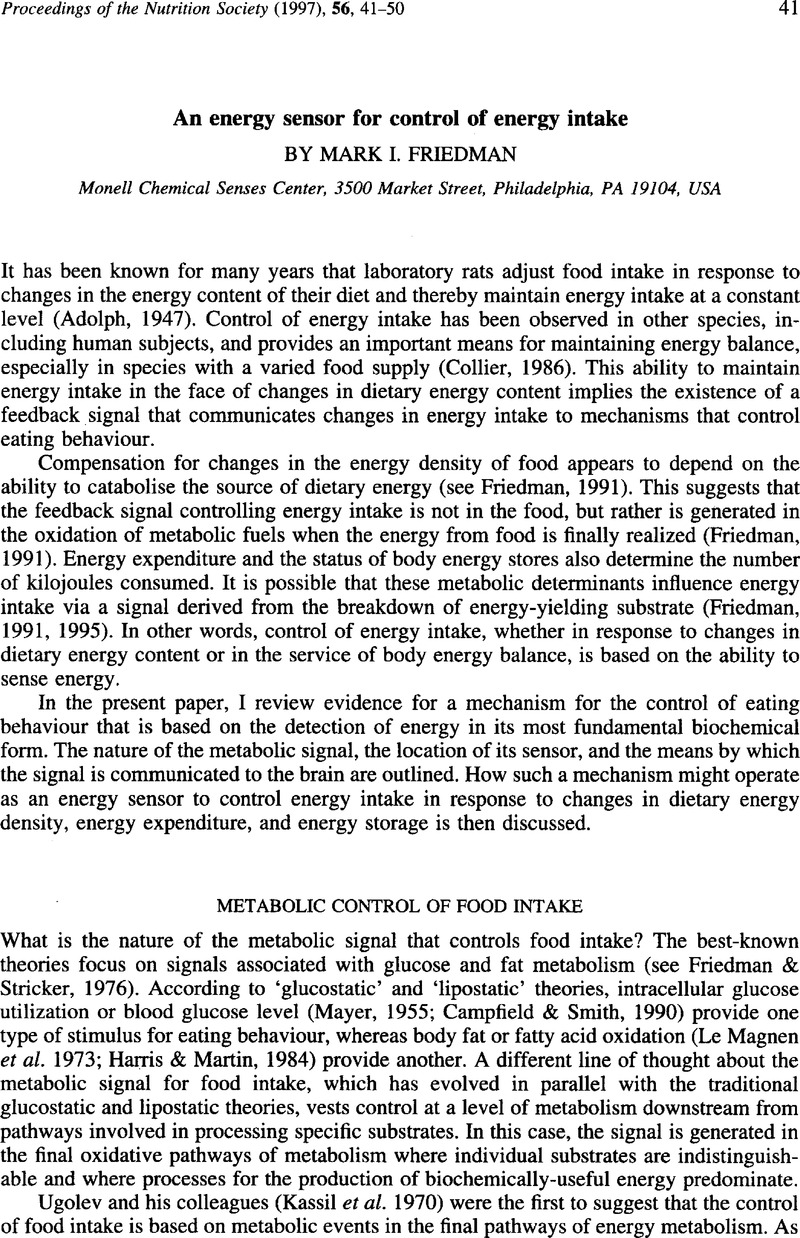Crossref Citations
This article has been cited by the following publications. This list is generated based on data provided by Crossref.
Provenza, Frederick D
Villalba, Juan J
Cheney, Carl D
and
Werner, Scott J
1998.
Self-organization of foraging behaviour: From simplicity to complexity without goals.
Nutrition Research Reviews,
Vol. 11,
Issue. 2,
p.
199.
Horn, Charles C.
Kaplan, Joel M.
Grill, Harvey J.
and
Friedman, Mark I.
1998.
Brain Fos-like immunoreactivity in chronic decerebrate and neurologically intact rats given 2,5-anhydro-d-mannitol.
Brain Research,
Vol. 801,
Issue. 1-2,
p.
107.
Horn, Charles C.
and
Friedman, Mark I.
1998.
Metabolic inhibition increases feeding and brain Fos-like immunoreactivity as a function of diet.
American Journal of Physiology-Regulatory, Integrative and Comparative Physiology,
Vol. 275,
Issue. 2,
p.
R448.
Langhans, Wolfgang
1999.
Neural and Metabolic Control of Macronutrient Intake.
Friedman, Mark
1999.
Neural and Metabolic Control of Macronutrient Intake.
Friedman, Mark I.
Harris, Ruth B.
Ji, Hong
Ramirez, Israel
and
Tordoff, Michael G.
1999.
Fatty acid oxidation affects food intake by altering hepatic energy status.
American Journal of Physiology-Regulatory, Integrative and Comparative Physiology,
Vol. 276,
Issue. 4,
p.
R1046.
French, Stephen J.
1999.
The effects of specific nutrients on the regulation of feeding behaviour in human subjects.
Proceedings of the Nutrition Society,
Vol. 58,
Issue. 3,
p.
533.
Silberbauer, Christa J.
Surina-Baumgartner, Denise M.
Arnold, Myrtha
and
Langhans, Wolfgang
2000.
Prandial lactate infusion inhibits spontaneous feeding in rats.
American Journal of Physiology-Regulatory, Integrative and Comparative Physiology,
Vol. 278,
Issue. 3,
p.
R646.
Buemann, Benjamin
Toubro, Søren
Raben, Anne
Blundell, John
and
Astrup, Arne
2000.
The acute effect of D-tagatose on food intake in human subjects.
British Journal of Nutrition,
Vol. 84,
Issue. 2,
p.
227.
Cox, James E.
Tyler, William J.
Randich, Alan
Kelm, Gary R.
Bharaj, Satinder S.
Jandacek, Ronald J.
and
Meller, Stephen T.
2000.
Suppression of food intake, body weight, and body fat by jejunal fatty acid infusions.
American Journal of Physiology-Regulatory, Integrative and Comparative Physiology,
Vol. 278,
Issue. 3,
p.
R604.
Bezouška, Karel
2001.
Glycoscience: Chemistry and Chemical Biology I–III.
p.
1325.
Richardson, Rosemary A
Garden, O.James
and
Davidson, H.Isobel
2001.
Reduction in energy expenditure after liver transplantation.
Nutrition,
Vol. 17,
Issue. 7-8,
p.
585.
Bezouška, Karel
2001.
Glycoscience.
p.
1325.
Buemann, Benjamin
and
Astrup, Arne
2001.
How does the body deal with energy from alcohol?.
Nutrition,
Vol. 17,
Issue. 7-8,
p.
638.
Booth, D.A.
2001.
Sensory, digestive and metabolic influences on preference and intake.
Appetite,
Vol. 36,
Issue. 1,
p.
63.
Miller, Cheryl C.
Martin, Roy J.
Whitney, Michelle L.
and
Edwards, Gaylen L.
2002.
Intracerebroventricular Injection of Fructose Stimulates Feeding in Rats.
Nutritional Neuroscience,
Vol. 5,
Issue. 5,
p.
359.
French, Stephen
and
Castiglione, Kate
2002.
Recent advances in the physiology of eating.
Proceedings of the Nutrition Society,
Vol. 61,
Issue. 4,
p.
489.
Schneider, Jill E.
and
Watts, Alan G.
2002.
Hormones, Brain and Behavior.
p.
435.
Flint, Anne
Helt, Berit
Raben, Anne
Toubro, Søren
and
Astrup, Arne
2003.
Effects of Different Dietary Fat Types on Postprandial Appetite and Energy Expenditure.
Obesity Research,
Vol. 11,
Issue. 12,
p.
1449.
Friedman, Mark I.
Graczyk-Millbrandt, Grazyna
Ji, Hong
Rawson, Nancy E.
and
Osbakken, Mary D.
2003.
2,5-Anhydro-d-mannitol increases hepatocyte sodium: transduction of a hepatic hunger stimulus?.
Biochimica et Biophysica Acta (BBA) - Molecular Cell Research,
Vol. 1642,
Issue. 1-2,
p.
53.



